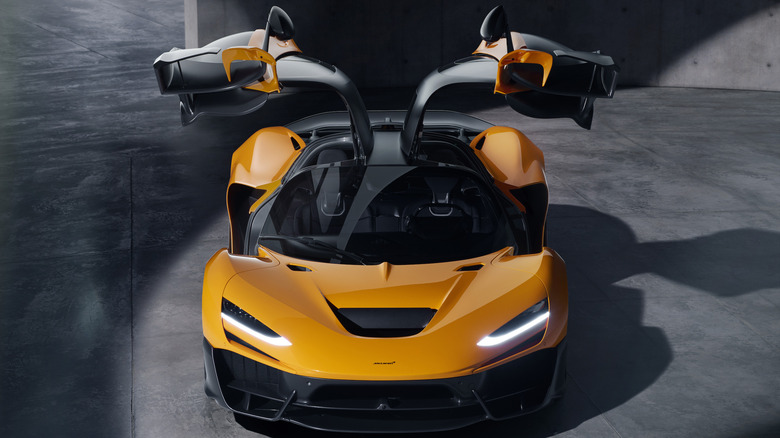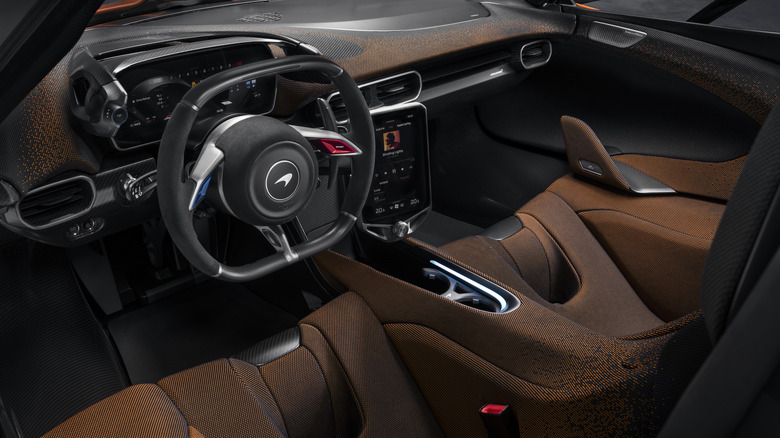McLaren's New W1 Supercar Taps F1 Aero For A Wild Top Speed: Everything We Know
McLaren promised to push the boundaries of performance with its next supercar, the highly-anticipated successor to the iconic F1 and P1. Today, the company has finally revealed the W1, which sets new records for speed and acceleration while also cramming more racetrack tech than has appeared in any vehicle from the British label so far. It's the fastest-accelerating consumer car ever produced by the brand, cutting it shorter by three seconds against the McLaren Senna, the fastest track-focused car in its portfolio.
The W1's new 4-liter twin-turbo 3,988cc V8 combustion engine, combined with an electric module on the hybrid powertrain, delivers a raw 1,258 bhp and 9,200 RPM output. For those interested in numbers, it can go from still to 186 mph in less than 13 seconds, while the 0-60 mph figures stand at 2.7 seconds. The maximum speed has been electronically capped at 217 mph. That's not quite in the same league as SSC Tuatara, Hennessey Venom GT, or the Koenigsegg Agera RS, but it does rub shoulders with the likes of the 2024 Lamborghini Revuelto and the 2024 Ferrari SF90 Stradale.
To give you an idea of exactly what this car is chasing from the get-go, the W1 embraces Pirelli P ZERO Trofeo RS tires as the standard format. There are unique suspension presets available for two Race modes, and a dedicated button that enables an aerodynamic system that has been developed from scratch for the W1. With the Boost option enabled, the driver gets the same kind of E-module power surge as the one inside Formula 1 cars for peak speed bursts.
Aerodynamics fitting for the 1 series legacy
The W1 also sets a whole bunch of new benchmarks, such as the highest power and combustion engine output, power-to-weight ratio, the fastest-accelerating, the fastest-lapping road-legal, the first to use pushrods, and the most advanced aerodynamic architecture to ever appear on a McLaren car. The aero wizardry has been lifted straight from the F1 textbooks, featuring Anhedral doors to improve the airflow as well as heat management while also incorporating what the carmaker claims are the "highest number of aerodynamic and active surface areas of any McLaren."
With Race Mode enabled, the W1 will tap into "shape-shifting" aerodynamics that generate up to 2,205 lbs of cornering downforce, working in tandem with front and rear wings. Powered by a total of six motors, these wings feed air under the car in the same fashion as Formula 1 speed demons. Even the brake and suspension system borrows tech from F1 rides, with the latter relying on ducts for aero cooling as well as dynamic downforce adjustment.
As the W1 goes from Road to Race mode, the height is adjusted at the front and well, while the new McLaren Race Active Chassis Control III suspension kit undergoes its own set of modifications — thanks to a heave system — to get the best out of the car's cutting-edge powertrain and aero duo. The signature Long Tail rear wing is not there merely for drag and lift correction but also plays a role in keeping the part integrity intact for when the driver hits speed bumps.
A high ask for McLaren exclusivity
The McLaren W1's bespoke braking system is no slouch either and can decelerate the W1 from 124 mph to zero in just 328 ft. The onboard EVSE charger can fill up the 1.384 kWh battery in just about 22 minutes. Borrowing inspiration from the Formula 1 sidepod design and employing carbon fiber even for the sun visors, the W1 also marks the debut of McLaren InnoKnit, a flexible material for interior styling with customization flexibility that extends down to the audio hardware.
Notably, the seats are integrated directly within the McLaren Aerocell carbon fibre monocoque. The steering wheel has been redesigned, and it's now flatter as well as more compact than other McLaren rides. The entire instrument binnacle also moves with the steering column for personal adjustments. The driver display, too, plays a role in aero flow from the HVAC system, while the McLaren Infotainment System (MIS II) serves Apple CarPlay convenience.
Of course, it's a top-shelf McLaren offering, one that builds on the famed "1" series. So, for anyone eyeing the W1, it's already too late. The company is only producing 399 cars, and all those units have already been booked by lucky enthusiasts. Pricing of the W1 starts at $2.1 million, but depending on the customization depth, it would only climb higher. All such personalization requests will pass through the McLaren Special Operations (MSO) program, which now digs deeper into unique customer-specific styling than ever before.







